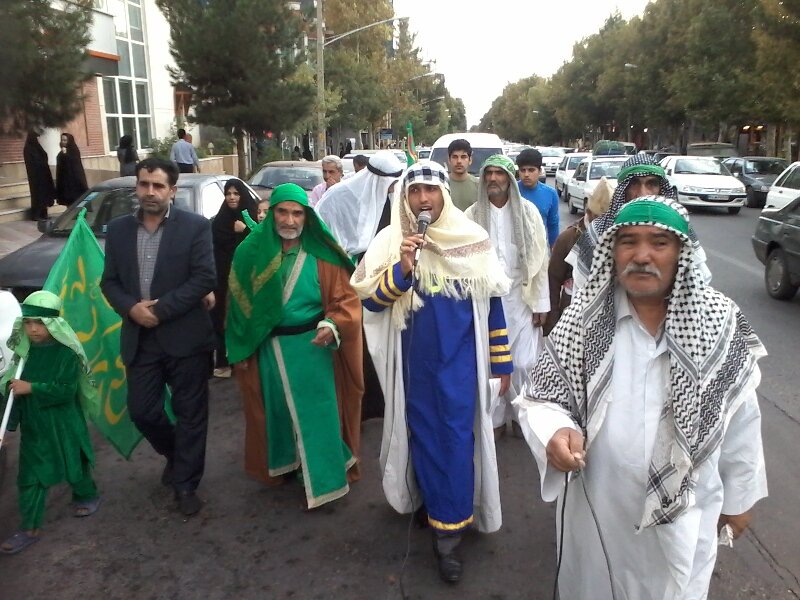Chavoshi reciting; a long-lasting tradition in Shahroud

Chavoshi is a Shiite religious song for departing and welcoming pilgrims to places of pilgrimage. The ritual of Chavoshi reading for pilgrims to the cities of Karbala, Mashhad, Najaf, Mecca, and Medina has been common since the Safavid and Qajar periods and has received much attention in the recent century. In addition to Semnan province and particularly Shahroud county, Chavoshi reading is also common in other provinces such as Khuzestan, Hormozgan, Bushehr, and the northern provinces of Iran.
"Chavosh" is a Turkish word, meaning a herald, courier, caravan leader, one who invites people to visit the holy shrines and the house of God, the Kaaba or Holy Cube.
In other words, Chavoshi is one of the types of oral literature. Chavoshi's collection of poems was recited in the ceremony of accompanying and welcoming the pilgrims of Mashhad, the pilgrims of Mecca, and the holy shrines. In the distant past, Chavoshi reciters were considered part of the expedition caravan; reciting poems, which included the praise of the Prophet Muhammad (Peace be upon him) and his family, because of the spiritual aspect hidden in it is considered a cultural heritage of Iranians. With the industrialization of societies, this tradition is on the verge of extinction, while the textual analysis of epic poems in Chavoshi reveals that these poems refer to the real aspects of the pilgrim's journey and purpose.
In addition to the court and government aspect, which was mainly praised by rulers and kings, it was also a popular ritual. This ceremony, as the heritage of Iranian culture, has changed in content with the entrance of Islam. In this section, instead of joy and applause, praise and glorification of Imams and religion replaced the praise of kings and rulers. Chavoshi reading among all the people was different from the method used by the courtiers. This tradition has long been popular among people in different parts of Iran.
Chavoshi reciters also played the role of the caravan awake and accompanied the caravans. They patrolled the caravan until the morning when the caravan was resting and walked around the caravan so that if they heard any sign of a bandit attacking the caravan or seeing a predator attacking the caravan. They blow the trumpets so that the women and children wake up and are not afraid of the sound of gunfire and the whistling of bullets, and the gunmen get ready. The Chavoshi singers had a good voice. They chose rhythmic poems based on the difficulty of the path and recited them during the journey. These poems were both instructive and relieved the travelers' fatigue.
In Shahroud, Chavoshi reciting is a means of informing the people of the neighborhood about the pilgrimage trips of individuals, which is more or less performed today. Chavoshi's poems are mostly made by the taste and imagination of enthusiasts, and their poets are often unknown; that is why some of Chavoshi's poems lack regular rhyme.
It is noteworthy that the families of the pilgrims both departing and arriving ceremonies serve sweets, local breads, and fruit juice or tea to the attendees and greeters during the Chavoshi ritual. Also, sacrifice sheep after returning for pilgrims and burn Sepand (plant seeds that burn to ward off evil eyes) in charcoal fireplaces.
Chavoshi themes
Looking at the poems of Chavoshi, they can be divided into three general sections in terms of structure based on the subject. The general structure of Chavoshi is divided into the following three sections based on the subject: Chavoshi before departure; Chavoshi along the way; Chavoshi on arrival.
Chavoshi is usually composed of Iranian music on the "Chahargah" instrument and is performed without the accompaniment of musical instruments and is usually sung by several people. Two or more singers exchange Chavoshi poems with a specific voice and answer each other. Women may even join men in this harmony.
Chavosh reciting requires more than anything esoteric purity, and sincerity, and in the next stage to gain experience and practice. After reaching the master's level, the experienced Chavoshi reciters tried to train students; therefore, they taught the learners steps such as reading the Chavosh texts, memorizing, consonant, and accompanying the skilled Chavosh.
Due to its artistic subtleties, Chavosh reciting was sometimes performed as a solo reading and sometimes as a consonant, which had a special atmosphere in the second form. In this type of Chavosh reading, pilgrims and accompanying people are in harmony with the Chavosh. In such a spiritual atmosphere, excitement and passion were everywhere and for a moment pilgrims and non-pilgrims were whispering to God Almighty and His saints. At the same time, spirituality caused people to forget if they had a grudge against each other in their hearts and to be ruled by love and empathy.
During the Qajar period, a lot of attention was paid to Chavoshi. After his first trip to Europe (1873), Nasser al-Din Shah intended to prepare a venue for the play in the style of European theater, imitating the architectural style of the Royal Albert Hall in London, but the clergy opposed the European style theater. It became a place for reciting Taziyeh or religious theater and sending travelers to Karbala, Najaf, Mashhad, Damascus, Mecca, and Medina. Chavoshi reading has grown significantly in the Qajar period, especially since the time of Nasser al-Din Shah. But according to available sources, this custom has been common since the Safavid period.
Dr. Seyedhossein Hosseiniseddiq is a faculty member at the Islamic Azad University

Leave a Comment